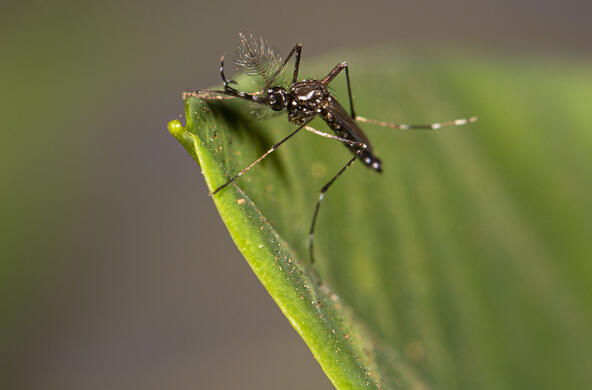As summer turns to fall, health officials in several Northeastern states are sounding the alarm on a rare but dangerous mosquito-borne disease: Eastern equine encephalitis (EEE). While an average of only 11 human cases are reported annually in the United States, Eastern equine encephalitis is deadly, with mortality rates up to 30 percent in those with severe disease, according to the US Centers for Disease Control and Prevention (CDC).
As of early September, at least seven people in New England have contracted the virus, a relatively high number for this time of year, with one fatality in New Hampshire. While 2024 has so far not seen any human cases in New York, the virus has been confirmed in horses in Orange, Ulster, and several other counties, killing a horse in the town of Newburgh in August, and prompting local public health warnings.
Despite the alarms, much about the virus’s spread is not well understood, says Dr. Shannon LaDeau, a disease ecologist at Millbrook’s Cary Institute of Ecosystem Studies. Though infections likely date back to at least the 1800s, the relative rarity of EEE in people means, for one thing, that the data just isn’t very comprehensive.
“With mosquitos and ticks in general, there is increasing public health recognition that human risk is changing and increasing in places where it didn’t used to be a problem."
—Dr. Shannon LaDeau, disease ecologist at Millbrook’s Cary Institute of Ecosystem Studies
Take the numbers around severe disease. As noted, CDC statistics state that about 30 percent of people with severe disease die, while those who survive generally have lifelong neurologic problems; the CDC also notes that about 95 percent of people infected with the EEE virus will avoid severe disease. But asked if this means that anyone bit by a mosquito carrying EEE virus will contract it, LaDeau says it’s not really known.
“It would absolutely not be surprising if three people could all get bit by the same mosquito and get exposed and have totally different outcomes,” LaDeau said. Factors like how much virus is in mosquito saliva, the length of the bite time, and individual human genetics all play roles.
Further complicating the picture are questions about why and how the virus, which has reservoirs in bird populations in the region, shows up in humans. EEE virus, LaDeau explained, appears to circulate widely between birds and mosquitos in certain intact forest wetland environments in the Northeast—and most of the time, it doesn’t impact humans.
When it does, she says, several things could be happening. It’s possible that mosquito species that focus on birds have a harder time finding avian blood meals later in the season and travel farther to bite humans; it’s also possible that more humans spending time in dense wooded environments offer more opportunities for exposure to the virus.
Eastern equine encephalitis is a vector-borne disease that is picked up from infected hosts by mosquitos who then infect other hosts. Mammals, includng horses and humans, are dead-end hosts.
But it’s also possible that early-season transmission between birds and mosquitos causes the virus to build up in those two populations, making it more likely that a different mosquito species—one that bridges the gap from infected bird to human—and is more abundant later in the year will transmit the virus to humans.
“The unknown here is that bridge vector. Is there a new mosquito species that’s particularly abundant this year that’s more likely to bite an infected bird and then survive and bite a human?” LaDeau asks. “We know that that is not the behavior of the main vector—Culiseta melanura—which is almost a bird specialist.”
There is also a likely climate dimension to the picture. While EEE has long existed in the region—unlike, say, dengue, which is spreading north due to climate change—local climatic factors, like a longer and wetter season, can lead to larger local mosquito populations in a given year, with more time to build up reservoirs of and transmit disease.
While EEE has primarily been a problem in the New England states in 2024, particularly Massachusetts, it is present in the Hudson Valley, confirmed in mosquitos and horses in Ulster and Orange counties.
While mosquito collection is done on a county-by-county basis, Danielle DeSouza, a spokesperson for the New York Department of Health, confirms that overall numbers are elevated this year.
“This has been a much higher year than usual for EEE—both in terms of number of horses testing positive, and in the number of counties where these horses were identified,” said DeSouza. While nowhere in the region has adopted the sort of curfews seen in Massachusetts, DeSouza says the state encourages taking precautions until the first hard frost. (This includes covering exposed skin when mosquitos are active, wearing repellent, ensuring window and door screens are intact, and removing standing water. Weekly statewide reports on mosquito-borne disease can also be found here.)
Asked about how the state currently assesses the risk to residents from EEE, DeSouza said there was concern, but that “risk decreases the farther we get into fall. With colder evenings and shorter days, mosquito activity will decrease as mosquitoes start to enter their overwintering state.”
Looking at the broader picture, LaDeau says more research is needed to be better prepared for viruses like EEE.
“With mosquitos and ticks in general, there is increasing public health recognition that human risk is changing and increasing in places where it didn’t used to be a problem,” LaDeau says. Still, better monitoring, particularly on the local level, is key.
“Understand[ing] where the vectors are and what they’re already carrying would put us a long way toward being able to understand how and why they’re changing,” she says.
Research on mosquito behavior is also essential to reliably evaluating the threat to people. “How do we better understand the difference between human cases and mosquito positivity?” LaDeau says, “Because I think that’s what we need to be able to predict.”








